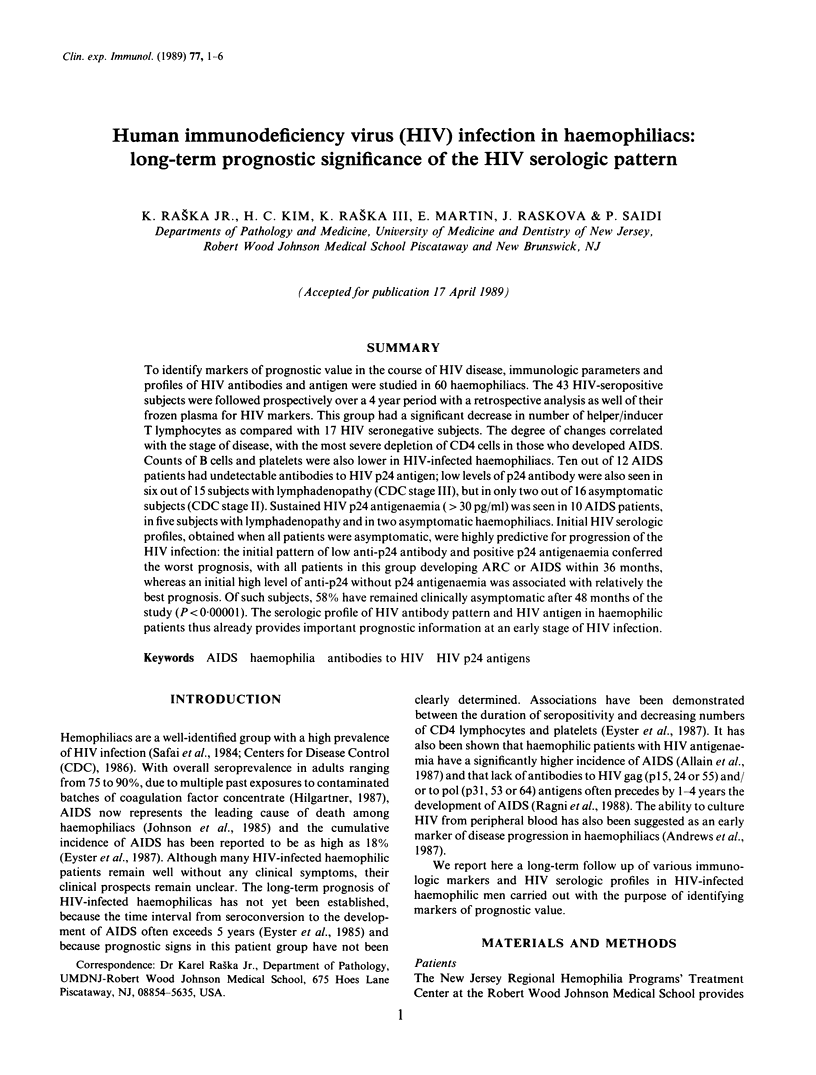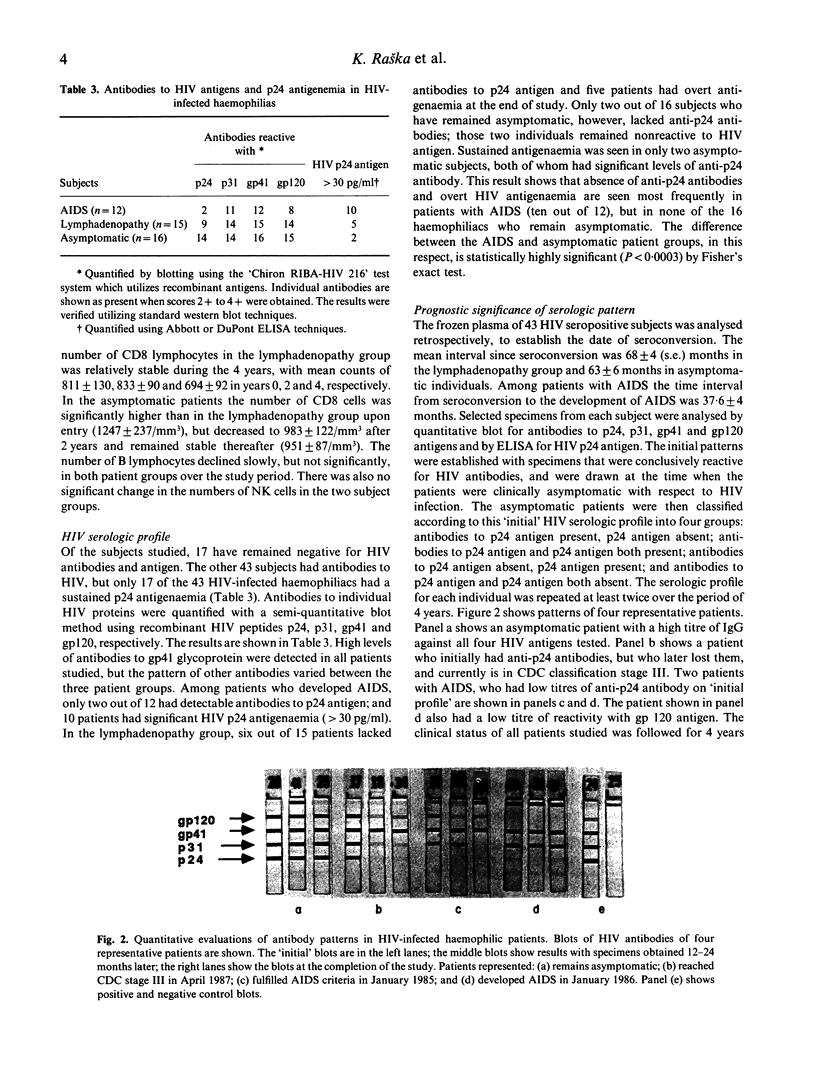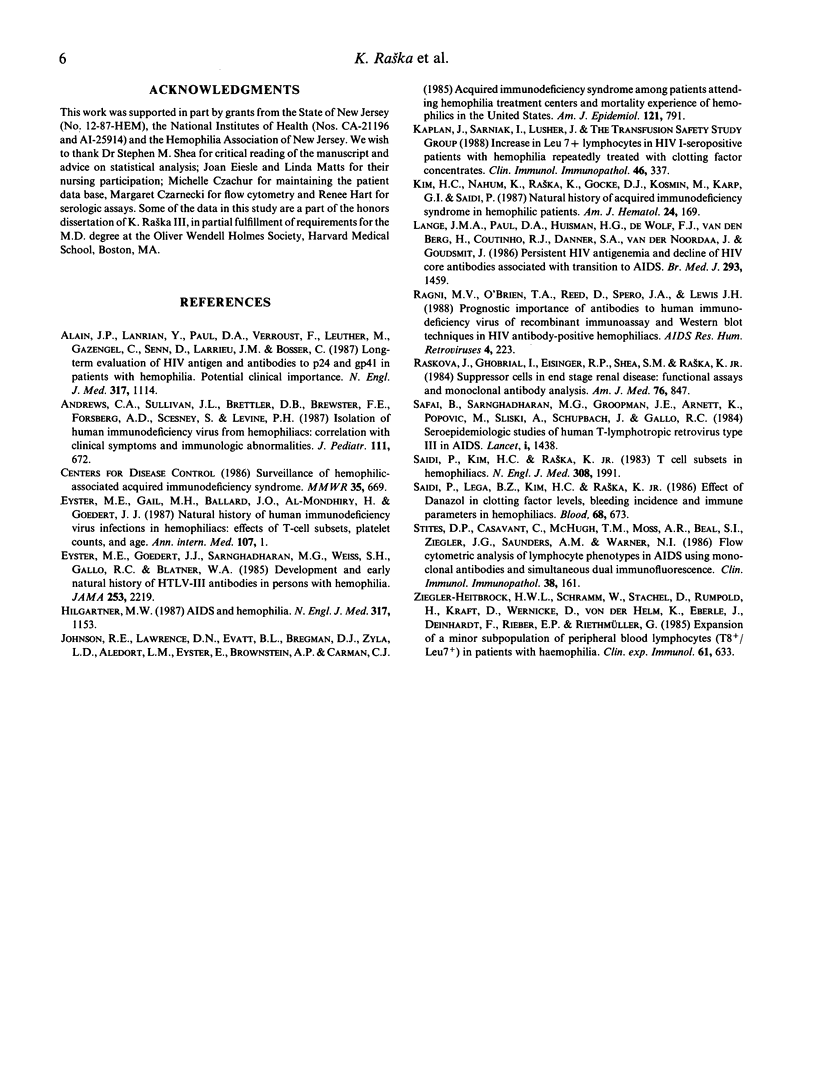Abstract
To identify markers of prognostic value in the course of HIV disease, immunologic parameters and profiles of HIV antibodies and antigen were studied in 60 haemophiliacs. The 43 HIV-seropositive subjects were followed prospectively over a 4 year period with a retrospective analysis as well of their frozen plasma for HIV markers. This group had a significant decrease in number of helper/inducer T lymphocytes as compared with 17 HIV seronegative subjects. The degree of changes correlated with the stage of disease, with the most severe depletion of CD4 cells in those who developed AIDS. Counts of B cells and platelets were also lower in HIV-infected haemophiliacs. Ten out of 12 AIDS patients had undetectable antibodies to HIV p24 antigen; low levels of p24 antibody were also seen in six out of 15 subjects with lymphadenopathy (CDC stage III), but in only two out of 16 asymptomatic subjects (CDC stage II). Sustained HIV p24 antigenaemia (greater than 30 pg/ml) was seen in 10 AIDS patients, in five subjects with lymphadenopathy and in two asymptomatic haemophiliacs. Initial HIV serologic profiles, obtained when all patients were asymptomatic, were highly predictive for progression of the HIV infection: the initial pattern of low anti-p24 antibody and positive p24 antigenaemia conferred the worst prognosis, with all patients in this group developing ARC or AIDS within 36 months, whereas an initial high level of anti-p24 without p24 antigenaemia was associated with relatively the best prognosis. Of such subjects, 58% have remained clinically asymptomatic after 48 months of the study (P less than 0.00001). The serologic profile of HIV antibody pattern and HIV antigen in haemophilic patients thus already provides important prognostic information at an early stage of HIV infection.
Full text
PDF





Images in this article
Selected References
These references are in PubMed. This may not be the complete list of references from this article.
- Allain J. P., Laurian Y., Paul D. A., Verroust F., Leuther M., Gazengel C., Senn D., Larrieu M. J., Bosser C. Long-term evaluation of HIV antigen and antibodies to p24 and gp41 in patients with hemophilia. Potential clinical importance. N Engl J Med. 1987 Oct 29;317(18):1114–1121. doi: 10.1056/NEJM198710293171804. [DOI] [PubMed] [Google Scholar]
- Andrews C. A., Sullivan J. L., Brettler D. B., Brewster F. E., Forsberg A. D., Scesney S., Levine P. H. Isolation of human immunodeficiency virus from hemophiliacs: correlation with clinical symptoms and immunologic abnormalities. J Pediatr. 1987 Nov;111(5):672–677. doi: 10.1016/s0022-3476(87)80241-x. [DOI] [PubMed] [Google Scholar]
- Eyster M. E., Gail M. H., Ballard J. O., Al-Mondhiry H., Goedert J. J. Natural history of human immunodeficiency virus infections in hemophiliacs: effects of T-cell subsets, platelet counts, and age. Ann Intern Med. 1987 Jul;107(1):1–6. doi: 10.7326/0003-4819-107-1-1. [DOI] [PubMed] [Google Scholar]
- Eyster M. E., Goedert J. J., Sarngadharan M. G., Weiss S. H., Gallo R. C., Blattner W. A. Development and early natural history of HTLV-III antibodies in persons with hemophilia. JAMA. 1985 Apr 19;253(15):2219–2223. [PubMed] [Google Scholar]
- Glass R. I., Holmgren J., Haley C. E., Khan M. R., Svennerholm A. M., Stoll B. J., Belayet Hossain K. M., Black R. E., Yunus M., Barua D. Predisposition for cholera of individuals with O blood group. Possible evolutionary significance. Am J Epidemiol. 1985 Jun;121(6):791–796. doi: 10.1093/oxfordjournals.aje.a114050. [DOI] [PubMed] [Google Scholar]
- Hilgartner M. W. AIDS and hemophilia. N Engl J Med. 1987 Oct 29;317(18):1153–1154. doi: 10.1056/NEJM198710293171810. [DOI] [PubMed] [Google Scholar]
- Kaplan J., Sarnaik I., Lusher J. Increase in Leu 2+ Leu 7+ lymphocytes in HIV 1-seropositive patients with hemophilia repeatedly treated with clotting factor concentrates. Clin Immunol Immunopathol. 1988 Mar;46(3):337–341. doi: 10.1016/0090-1229(88)90052-9. [DOI] [PubMed] [Google Scholar]
- Kim H. C., Nahum K., Raska K., Jr, Gocke D. J., Kosmin M., Karp G. I., Saidi P. Natural history of acquired immunodeficiency syndrome in hemophilic patients. Am J Hematol. 1987 Feb;24(2):169–176. doi: 10.1002/ajh.2830240208. [DOI] [PubMed] [Google Scholar]
- Lange J. M., Paul D. A., Huisman H. G., de Wolf F., van den Berg H., Coutinho R. A., Danner S. A., van der Noordaa J., Goudsmit J. Persistent HIV antigenaemia and decline of HIV core antibodies associated with transition to AIDS. Br Med J (Clin Res Ed) 1986 Dec 6;293(6560):1459–1462. doi: 10.1136/bmj.293.6560.1459. [DOI] [PMC free article] [PubMed] [Google Scholar]
- Ragni M. V., O'Brien T. A., Reed D., Spero J. A., Lewis J. H. Prognostic importance of antibodies to human immunodeficiency virus by recombinant immunoassay and Western blot techniques in HIV antibody-positive hemophiliacs. AIDS Res Hum Retroviruses. 1988 Jun;4(3):223–231. doi: 10.1089/aid.1988.4.223. [DOI] [PubMed] [Google Scholar]
- Raskova J., Ghobrial I., Shea S. M., Eisinger R. P., Raska K., Jr Suppressor cells in end-stage renal disease. Functional assays and monoclonal antibody analysis. Am J Med. 1984 May;76(5):847–853. doi: 10.1016/0002-9343(84)90996-3. [DOI] [PubMed] [Google Scholar]
- Safai B., Sarngadharan M. G., Groopman J. E., Arnett K., Popovic M., Sliski A., Schüpbach J., Gallo R. C. Seroepidemiological studies of human T-lymphotropic retrovirus type III in acquired immunodeficiency syndrome. Lancet. 1984 Jun 30;1(8392):1438–1440. doi: 10.1016/s0140-6736(84)91933-0. [DOI] [PubMed] [Google Scholar]
- Saidi P., Lega B. Z., Kim H. C., Raska K., Jr Effect of danazol on clotting factor levels, bleeding incidence, factor infusion requirements, and immune parameters in hemophilia. Blood. 1986 Sep;68(3):673–679. [PubMed] [Google Scholar]
- Stites D. P., Casavant C. H., McHugh T. M., Moss A. R., Beal S. L., Ziegler J. L., Saunders A. M., Warner N. L. Flow cytometric analysis of lymphocyte phenotypes in AIDS using monoclonal antibodies and simultaneous dual immunofluorescence. Clin Immunol Immunopathol. 1986 Feb;38(2):161–177. doi: 10.1016/0090-1229(86)90135-2. [DOI] [PubMed] [Google Scholar]
- Ziegler-Heitbrock H. W., Schramm W., Stachel D., Rumpold H., Kraft D., Wernicke D., von der Helm K., Eberle J., Deinhardt F., Rieber E. P. Expansion of a minor subpopulation of peripheral blood lymphocytes (T8+/Leu 7+) in patients with haemophilia. Clin Exp Immunol. 1985 Sep;61(3):633–641. [PMC free article] [PubMed] [Google Scholar]



